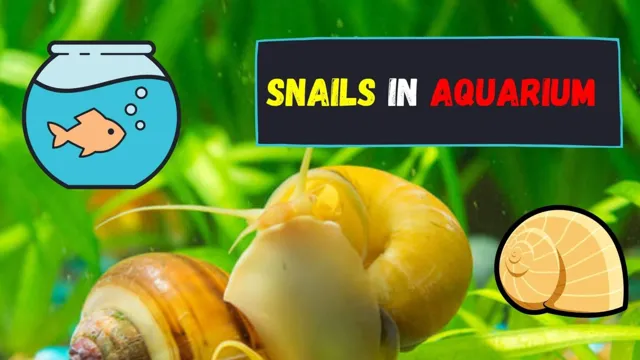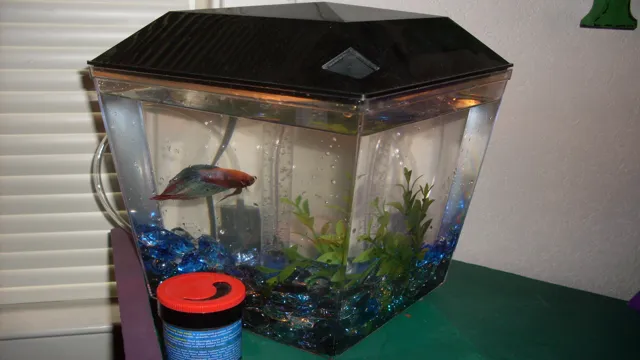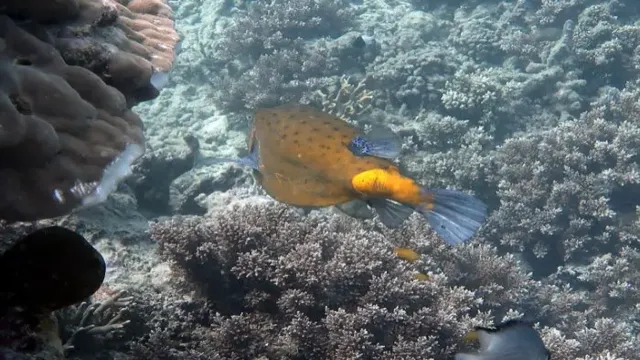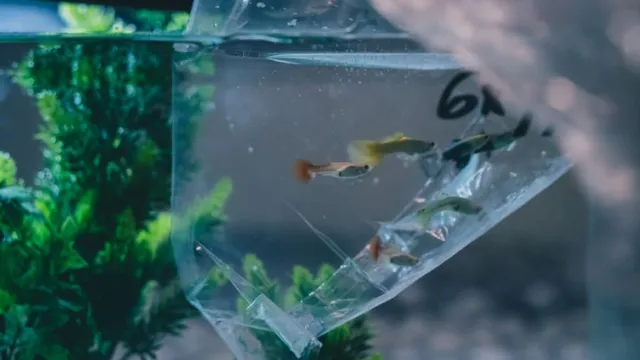Snails can be a beautiful addition to an aquarium, but they can also cause problems if introduced to a tank unintentionally. If you’ve recently purchased a bag of plants or fish for your aquarium, you may have noticed some unwanted snails clinging to the sides. Removing snails from an aquarium bag can be a tricky task, but it’s important to do so to prevent an influx of snails in your tank.
In this blog post, we’ll discuss the best methods for safely and effectively removing snails from an aquarium bag. Whether you’re a seasoned aquarist or new to the hobby, you’ll find useful tips and tricks to ensure your tank stays snail-free. So, grab your gloves and get ready to dive into the world of snail removal!
Assessing the Situation
If you’re dealing with snails in your aquarium bag, the first step is to assess the situation and determine the extent of the problem. Are there just a few snails, or is it a full-blown infestation? The answer will determine how you approach getting rid of them. If there are only a few snails, you may be able to simply remove them by hand.
However, if there are many snails, it’s best to use a snail trap or chemical solution to eliminate them. It’s essential to act quickly before the snails breed and the problem gets worse. Regularly checking your aquarium and being vigilant with cleaning can help prevent snails from taking over in the future.
Remember, prevention is always better than cure. By taking steps to maintain a healthy and balanced aquarium environment, you can avoid snail problems altogether.
Check the Bag for Snails
If you’re a gardener, you’re no stranger to the potential threat of pesky snails and slugs. They can wreak havoc on your precious plants, and once they set up shop, they’re not easy to get rid of. That’s why it’s important to be proactive and assess the situation before it gets out of hand.
One simple way to do that is by regularly checking your bag of gardening supplies for any unwanted hitchhikers. Snails and slugs will often hide in dark, damp spaces, so it’s not uncommon for them to sneak into your bag when you’re not looking. By being diligent and checking for these intruders, you can prevent them from invading your garden and causing damage.
Remember: an ounce of prevention is worth a pound of cure!

Check the Aquarium for Snails
If you’re wondering whether or not there are snails in your aquarium, the first step is to assess the situation. Take a few moments to observe your aquarium closely. Are there any unusual signs of snail activity, such as trails or slimy residue on the glass walls? Are there any shells or other debris that could indicate the presence of snails? Additionally, you can try turning off the light and observing the aquarium at night.
Snails are nocturnal creatures, and they often become more active after the lights are turned off. If you do see signs of snails, it’s important to take action quickly. Snails can reproduce rapidly, and if left unchecked, they can quickly become a problem for your entire aquarium ecosystem.
Regularly checking your aquarium for snails and other unwanted pests is an important part of maintaining a healthy aquarium environment.
Consider Using a Separate Container
When it comes to containerization, it’s important to assess the situation before deciding whether or not to use a separate container. Factors such as the size and complexity of the application, as well as the availability of resources, should be taken into consideration. One advantage of using a separate container is the ability to isolate specific components of the application, which can be beneficial for testing and troubleshooting purposes.
However, this also requires additional resources and can lead to increased complexity. It’s important to weigh the pros and cons and determine whether the benefits outweigh the costs. Overall, using a separate container can be a valuable tool for certain situations, but it’s important to carefully consider the specific needs of the application before making a decision. (See Also: How to Calculate Corner Aquarium Volume: A Step-by-Step Guide)
Removing the Snails
Are you tired of snails taking over your aquarium bag? Don’t worry, there are a few ways to remove them. Firstly, you can try manually removing them with a net or tweezers, being careful not to harm other aquatic creatures. Another method is to place a piece of lettuce or cucumber at the bottom of the bag overnight.
The snails will be attracted to the food, and you can remove them in the morning. Additionally, there are commercial snail removal products on the market that are safe for aquariums. However, make sure to read the instructions carefully and follow them precisely.
It’s important to address the snail issue before it gets out of control, as they can quickly multiply and become a nuisance to your aquatic environment. So, take action now and say goodbye to those pesky snails once and for all!
Siphoning the Snails
If you’re dealing with an overpopulation of snails in your aquarium, it’s essential to remove them to avoid their harm to your aquatic plants and fish. One of the easiest ways to eliminate snails from your tank is by siphoning them out. You can do this by using a siphon or a turkey baster, depending on the number of snails present.
Place the siphon or turkey baster above the snail, making sure it’s entirely covered, then suck the water, and the snail should move up. It’s essential to be extremely gentle when doing this, so as not to harm the snails. Once you’ve siphoned the snails, place them in a different container before removing them from the aquarium completely.
Finally, you can introduce natural predators to your tank, such as assassin snails or puffers, which can help minimize the snail population over time. By taking these steps and being diligent in your efforts, you can remove the snails from your tank and maintain a healthy aquatic environment for your fish and other aquatic species.
Handpicking the Snails
When it comes to preparing snails for consumption, the first step is typically handpicking the snails from their natural habitat. This process involves a keen eye to spot them and a steady hand to remove them from their environment without damaging the snail itself. It’s essential to use only snails that are alive, healthy, and free from disease or other contaminants.
The best time to find snails is usually after a rainfall or in the early morning, as they tend to crawl out of hiding and can be more easily spotted. Handpicking the snails takes time and patience, but it’s crucial to ensure that the snails used for consumption are of the highest quality. Once all the snails are gathered, they should be rinsed thoroughly and kept in a cool, damp place until they’re ready to be prepared.
Remember, the overall taste of your snail dish depends heavily on how carefully you handpick them in the first place.
Using a Trap to Catch the Snails
If snails are wrecking havoc in your garden, using a trap is an effective way to remove them. The first step is to locate the snails’ favorite hiding spots, such as damp areas or under rocks and plant pots. Then, fill an empty tuna can or small container with beer and bury it in the soil so that the top of the can is level with the ground.
The snails will be attracted to the beer and fall into the can, unable to crawl out. In the morning, dispose of the can and snails. Another option is to place a board or piece of cardboard on the ground where the snails gather. (See Also: How to Grow Aquarium Plants Out of Water: A Comprehensive Guide for Beginners)
They will crawl under the board to hide during the day, and you can simply pick up the board and remove the snails manually. Whichever method you choose, be sure to consistently monitor your garden for new snail activity and take appropriate action to prevent future infestations. With a little effort and persistence, you can successfully remove snails and protect your beloved plants.
Preventing Future Snail Infestations
If you want to prevent future snail infestations in your aquarium, there are a few steps you can take. First, make sure any new plants or fish you add to your tank are thoroughly inspected for snails or their eggs. You can also quarantine any new additions for a few weeks to ensure they are free of any unwanted hitchhikers.
Another preventative measure is to avoid overfeeding your fish, as excess food can attract snails and provide them with a food source. It’s also a good idea to regularly clean your aquarium, removing any debris or uneaten food that may be sitting on the bottom of the tank. Finally, if you do find snails in your aquarium, there are a few methods you can use to get rid of them, such as removing them manually or using snail traps.
By taking these precautions, you can help ensure that your aquarium remains snail-free and healthy for your fish. And if you ever do need to get snails out of an aquarium bag, simply rinse the bag thoroughly and inspect it carefully before using it again to prevent any unwanted visitors from entering your tank.
Quarantining New Plants and Fish
When it comes to adding new plants and fish to your aquarium, the last thing you want is a snail infestation. These pesky little creatures can quickly multiply and overrun your tank, causing a host of problems. To prevent this from happening, it’s important to quarantine new plants and fish before adding them to your existing setup.
This allows you to carefully inspect them for any signs of snails or other unwanted pests. Additionally, you can use this time to acclimate your new additions to your tank’s specific environment. By taking these precautions, you can avoid potential snail infestations and keep your aquarium healthy and thriving.
Managing Overfeeding and Waste
If you’re keeping snails as pets, overfeeding them can lead to future infestations. To prevent this from happening, it’s important to manage the feeding process carefully. While snails have voracious appetites, it’s important not to give them more than they can handle.
Overfeeding can lead to waste, which can attract more snails and cause an infestation. It’s also important to clean up any uneaten food on a regular basis, as this can also attract unwanted pests. To manage this effectively, it’s best to feed your snails small amounts at a time and wait until they finish before adding more.
By taking these steps, you can keep your snails healthy and prevent future infestations from occurring.
Adding Predator Fish or Invertebrates
If you’re looking to prevent future snail infestations in your aquarium, adding predator fish or invertebrates can be an effective solution. These natural predators can help keep snail populations in check by consuming them as a food source. Some common predator fish for snails include loaches, pufferfish, and certain species of cichlids.
Alternatively, adding invertebrates like assassin snails or crayfish can also be effective at controlling snail populations. However, it’s important to research and carefully select predators that are compatible with your existing fish and plants to ensure a balanced ecosystem. By introducing these natural predators, you can maintain a healthier and more balanced aquarium environment.
Conclusion
In conclusion, getting snails out of an aquarium bag can be a slippery situation, but with a little bit of patience and persuasion, you can successfully evict these slimy creatures. Just remember to empty the bag over a sink or container, gently coax the snails out with a net or your hands, and offer them a new home in a different body of water. And if all else fails, just tell them that the grass is always greener on the other side, or in this case, the algae is always stickier on the other glass. (See Also: How to Make an Aquarium Powerhead Output Not As Strong: Simple Ways)
Happy snail wrangling!”
FAQs
What are the common causes of snails in an aquarium bag?
Snails can enter an aquarium bag through infested plants or decorations. They can also hitchhike on newly acquired fish or aquarium equipment.
Can snails harm aquarium fish?
In most cases, snails are harmless to aquarium fish. However, some larger snails can eat fish eggs or small fish.
How to prevent snails from entering an aquarium bag?
To prevent snails from entering an aquarium bag, inspect plants and decorations for snails before adding them to the aquarium. Quarantine newly acquired fish and aquarium equipment before adding them to the tank.
What are the signs of a snail infestation in an aquarium?
The signs of a snail infestation in an aquarium include an increase in the number of snails, snail eggs on plants and decorations, and debris from snail waste.
Can snails overpopulate an aquarium?
Yes, snails can overpopulate an aquarium if not kept under control. This can cause an increase in waste and ammonia levels, which can harm fish and other aquatic life.
What are some ways to control a snail population in an aquarium?
Some ways to control a snail population in an aquarium include manually removing them, using snail traps, and introducing natural predators such as assassin snails.
Is it safe to use chemicals to remove snails from an aquarium?
It is not recommended to use chemicals to remove snails from an aquarium as they can harm other aquatic life and affect the water chemistry. It is best to use natural methods of snail control.







